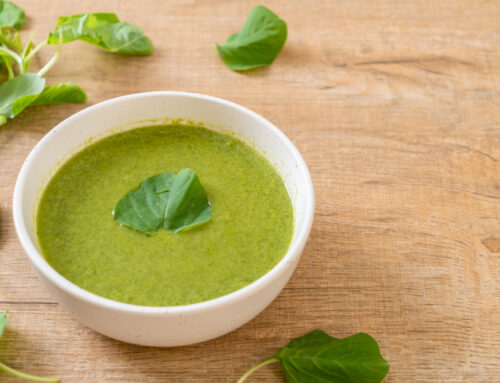By: Dr. Kathleen Regan, ND
Humans have been consuming cow dairy for thousands of years. In fact, a recent archaeological dig from Britain showed that prehistoric farmers were consuming dairy products as early as 6,000 years ago – despite being lactose intolerant! And we are still at it! Humans consume dairy in volumes despite it being linked to a number of problematic health issues such as diarrhea, constipation, dermatitis, eczema, respiratory conditions and more.
Cow dairy offers a creamy, satiating food that is readily accessible. Its nutritional profile is noteworthy with 1 cup of 2% milk offering 8g of protein, 5g of fat, 30% of daily calcium requirement as well as naturally occurring Vitamin A and B6. However, despite this healthy profile, milk seems to cause a lot of problems for a lot of people. In Canada, close to 7% of the population report a food allergy. At the top of the list of reported food allergens is dairy with 2% of the Canadian population reporting an actual Cow’s Milk Allergy (CMA). This is the highest reported food allergen in Canada!
Anecdotally, from my clinical practice, many patients speculate that dairy is a trigger for their health concerns. However, they are often told that ‘there is no evidence’ that milk or dairy-based foods is an inflammatory or immune-triggering food – and so they don’t eliminate dairy. I am always surprised to hear this as there is plenty of evidence that milk is problematic. Here are a few reasons why:
Cow’s Milk Allergy (CMA)
A true IgE allergy to milk affects 2% of the population with some estimates being higher (1,2). It is a hypersensitivity reaction in which symptoms usually occur within minutes to 1 to 2 hours of ingestion. Symptoms include:
- Sudden skin rash (urticaria)
- Angioedema
- Throat tightness
- Respiratory symptoms, including difficulty breathing, coughing, and wheezing
- Gastrointestinal symptoms, including abdominal pain, vomiting, and diarrhea
- Cardiovascular symptoms, including dizziness, confusion, and hypotension
Casein Protein Intolerance
There are whey and casein proteins in most animal dairy (goat, sheep and cow) and all can cause sensitivity reactions. This is why individuals who are frankly allergic to cow dairy will likely be allergic to goat and sheep dairy. However, some breeds of cows produce more ‘A1 beta-casein protein’ then ‘A2 beta-casein protein’. It is speculated that the A1 casein protein was bred into cow populations who were chosen for their higher milk-yield. These include cow breeds such as Holstein, Friesian, Ayrshire, and British Shorthorn. Other breeds produce mainly the A2 casein protein and include Guernsey, Jersey, Charolais, and Limousin cows. The A1 casein protein has been found to slow digestion, trigger inflammation and cause bloating, gas, abdominal pain, diarrhea and constipation. This is thought to be caused by beta-casomorphin-7 (BCM-7) which is an opioid peptide released during digestion of A1 Casein. These symptoms can occur independent of a cow’s milk allergy and current research is unclear on how many people this affects (3, 4).
Mixed or Non-IgE Mediated Dairy Sensitivity
There are also ‘mixed and non-IgE mediated’ forms of dairy sensitivity that are difficult to diagnose and complicate assessment of CMA. Cow’s milk is often identified as the culprit through history and elimination diets – it is not always identified on an IgE test (classic allergy test). These ‘mixed’ reaction symptoms include:
- Atopic dermatitis (skin rash)
- Allergic eosinophilic esophagitis (symptoms include difficulty swallowing, heart burn, chest pain, upper abdominal pain
- Eosinophilic gastritis. (Symptoms include difficulty swallowing, heartburn, abdominal pain, nausea, vomiting, diarrhea, weight loss and bloating.
It is possible that these symptoms are linked to the A1 casein protein although this needs to be confirmed with more research.
Lactose Intolerance
Lactose intolerance is prevalent with up to 17% (7 million) of Canadians reporting an issue digesting milk. It is well known that certain populations lack the enzyme, lactase, needed to break down the lactose sugar. It is also known that numerous individuals have lactose intolerant symptoms without testing positive for lactose intolerance (4, 5)
Evidence in the Numbers
If you add all this up, we could assume that beyond 20% of the Canadian population experiences significant irritation from dairy. From the well-known reactions above, it is clear that dairy can cause inflammation and immune-mediated reactions in the esophagus, stomach, intestines, lungs and skin. This is why Naturopathic Doctors recommend dairy removal in the following conditions: non-acute tongue swelling, difficulty swallowing, reflux, stomach or abdominal pain, diarrhea, constipation, difficulty breathing (asthma), chronic sinus conditions, chronic inner ear infections, acne, eczema and atopic dermatitis.
The Gut & The Immune System
It is also important to consider that the gut and microbiome are our first line of immune defence. If there is chronic irritation and damage to the digestive track, then it is more likely that autoimmunity will follow (6). Therefore, any food that causes chronic inflammation and irritation of the immune system could cause a whole range of health problems.
It seems practical to remove dairy products for a trial period, specifically in acute or chronic conditions of the upper and lower respiratory track, digestive system and skin. Although controversial, I also include ear, sinus, nose and throat conditions here because they are all connected to the same physical pathway and it seems logical. Removing dairy is a simple solution that is relatively easy to try without compromising nutrition. Despite concerns of calcium deficiency, calcium is relatively easy to find in other foods. Vitamin D is best supplemented but can also be found in foods and through sun exposure.
Why then, the Controversy?
Why is there controversy surrounding cow dairy if there is so much evidence of health complications? Part of this pro-dairy stance comes from the perceived health benefits. There is a body of research that has supported a positive long-term role of cow dairy in health. However, more recent meta-analyses of large populations have found conflicting and concerning evidence of the long term role of dairy consumption in chronic disease including specific cancers, heart disease, diabetes, obesity and more. Click link to read more.
Conclusions:
When milk is tolerated, there is certainly an argument for its nutritional value. However, an increasing volume of research is suggesting that we need to take a closer look at how much we are consuming in relation to our health. Cow breeding and handling practices further complicate this discussion and may play a role in some of the adverse health effects related to dairy consumption.
When milk is not tolerated or when a cluster of symptoms appear that are in alignment with milk allergy or intolerance – there are some simple steps that can help identify milk as the culprit or innocent bystander.
Naturopathic Tips for Cutting Out Dairy:
- Conditions of Main Concern: These are the symptoms that make a Naturopathic Doctor think of dairy elimination including chronic tongue swelling, difficulty swallowing, reflux, stomach or abdominal pain, diarrhea, constipation, difficulty breathing, chronic sinus conditions, chronic inner ear infections, acne, eczema, atopic dermatitis.
- Length of Elimination: The length of time you should cut out dairy depends on your health goals. If you are concerned about long-term health – this may be a more permanent change. If you feel that dairy is an important part of your daily nutrition BUT are concerned it is causing a health problem then a 12 week to 12 month elimination is a good place to start. Track your symptoms. Slowly begin to reintroduce milk over a period of 3 weeks. Many people don’t notice their improvements until they reintroduce dairy and symptoms flare again.
- Preparation: Be prepared with substitutes. If dairy is a staple in your diet, then you may miss it dearly. But there are tasty alternatives! Educate yourself on the different dairy alternatives and how you can integrate them in your life. There are multitudes of milk substitutes. There are a number of yogurt alternatives. Cheese choices are not as palatable but have come a long way. Try to choose from a range of options and avoid focusing solely on soy-based alternatives which can also be allergenic.
- Eat Your Calcium: Calcium is bioavailable from many other foods as discussed above. It is a very achievable goal to get your 1000-1200mg of calcium from food.
- Supplement Your Vitamin D: It can be trickier to get 1000IU of active Vitamin D from food and it may be best supplemented. It can be found in cod liver oil, fatty fish, egg yolks, mushrooms and fortified foods.
- Support your Gut: Remember that most immune conditions are influenced by inflammation in the gut and damage to the microbiome (our gut bacteria). Remember to consider strategies to reduce inflammation and build up a healthy community of gut bacteria.
References
- Flom JD, Sicherer SH. Epidemiology of Cow’s Milk Allergy. Nutrients. 2019;11(5):1051.
- Sackesen C, Assa’ad A, Baena-Cagnani C, et al. Cow’s milk allergy as a global challenge. Curr Opin Allergy Clin Immunol 2011;11:243-248.
- Costa WK, Souza EL, Beltrão-Filho EM, et al. Comparative protein composition analysis of goat milk produced by the Alpine and Saanen breeds in northeastern Brazil and related antibacterial activities. PLoS One. 2014;9(3):e93361.
- Pal S, Woodford K, Kukuljan S, Ho S. Milk Intolerance, Beta-Casein and Lactose. Nutrients. 2015;7(9):7285–7297. Published 2015 Aug 31. doi:10.3390/nu7095339
- Barr SI. Perceived lactose intolerance in adult Canadians: a national survey. Appl Physiol Nutr Metab. 2013 Aug;38(8):830-5.
- Campbell AW. Autoimmunity and the gut. Autoimmune Dis. 2014;2014:152428.
Other Resources:
- Iacono G, Cavataio F, Montalto G, et al. Intolerance of cow’s milk and chronic constipation in children. N Engl J Med 1998;339:1100-1104.
- Juhl CR, Bergholdt HKM, Miller IM, Jemec GBE, Kanters JK, Ellervik C. Dairy Intake and Acne Vulgaris: A Systematic Review and Meta-Analysis of 78,529 Children, Adolescents, and Young Adults. Nutrients. 2018;10(8):1049.
- Lucendo AJ, Arias Á, González-Cervera J, Yagüe-Compadre JL, Guagnozzi D,Angueira T, Jiménez-Contreras S, González-Castillo S, Rodríguez-Domíngez B, De Rezende LC, Tenias JM. Empiric 6-food elimination diet induced and maintained prolonged remission in patients with adult eosinophilic esophagitis: a prospective study on the food cause of the disease. J Allergy Clin Immunol. 2013Mar;131(3):797-804.
- Murray MG, Kanuga J, Yee E, Bahna SL. Milk-induced wheezing in children with asthma. Allergol Immunopathol (Madr) 2013;41:310-314.
- Pelikan Z. Asthmatic response to milk ingestion challenge in adults: a comparison of the open and double-blind challenges. Int Arch Allergy Immunol 2013;161:163-173.
- von Berg A, Filipiak-Pittroff B, Krämer U, et al. Allergies in high-risk schoolchildren after early intervention with cow’s milk protein hydrolysates: 10-year results from the German Infant Nutritional Intervention (GINI) study. J Allergy Clin Immunol 2013;131:1565-1573






